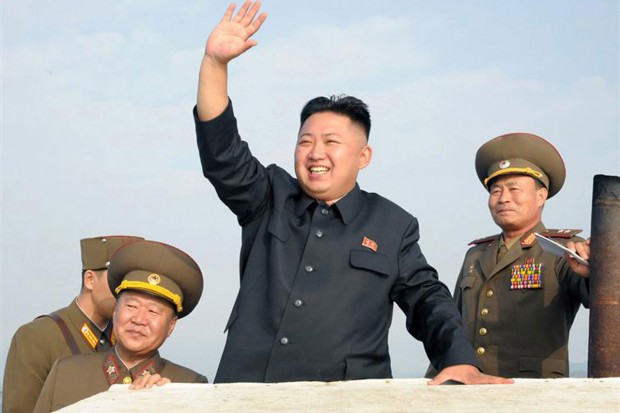
The latest round of threats exchanged by North Korea and the United States is dragging on longer and taking on a more virulent tone than in the past, provoking deep concerns among American officials and their allies.
Following blustery warnings by Kim Jong Un, North Korea’s 30-year-old leader, and videos depicting North Korean attacks on the United States, the Obama administration took the unprecedented step this week of sending two stealth bombers to South Korea as part of an ongoing military training exercise.
But despite the escalating tensions, U.S. officials said they have focused more closely on what North Korea is doing than on what it is saying.
“Putting on a show is not the same as taking action,” said a senior administration official, who spoke on the condition of anonymity to discuss the volatile situation. “Describing the situation as akin to war is not to be remotely confused with wanting a war, let alone going to war.”
The senior official and others said that U.S. military commanders are closely watching the situation, which has escalated since North Korea conducted a nuclear weapons test in December. In addition, officials cited new levels of cooperation and mutual confidence between the United States and allies in South Korea and Japan.
While a direct attack on U.S. forces on the mainland or in the Pacific seems unlikely, nongovernment analysts said the rising tensions increase the risk of some form of limited armed conflict. North Korea recently cut off its military phone line with the South, which is used to coordinate logistics along the demilitarized border buffer.
In a new escalation of rhetoric early Saturday, North Korea’s official KCNA news agency reported that the country was entering a “state of war” with South Korea and that “all issues raised between the North and the South will be handled accordingly.”
Some experts noted that South Korea also has adopted a more aggressive rhetorical posture. Senior officials quoted anonymously in the media have suggested that plans have been drawn up for “surgical strikes” against North Korea.
“The level and scope of the rhetoric [in North Korea] is stronger than in the past,” said Scott A. Snyder, a Korea expert at the Council on Foreign Relations. “This time we’ve seen a higher level of threat, delivered at a higher level.”
He added, “There’s room for miscalculation right now.”
Earlier this month, the Pentagon announced it was significantly bolstering America’s missile defense capabilities on the West Coast. Secretary of Defense Chuck Hagel said Thursday that the United States has no option but to take Pyongyang’s threats seriously.
But the decision to include B-2 bombers flown from Missouri in the military exercise with South Korea was made some time ago, the senior official said, adding that U.S. “strategic air assets” would be a part of the annual exercise “from this point forward.”
“It’s not something that just came up last week” in response to Kim’s verbal and video threats, the official said. “But it is certainly the case that following North Korea’s decision in December to conduct a nuclear test . . . both the United States and our allies recognized the need to ensure that there were consequences and that our deterrence was visible.”
Christopher R. Hill, a former U.S. diplomat who served as ambassador in Seoul in 2004 and later led a negotiating team that sought to eliminate the North Korean nuclear threat, said the current standoff appears “more serious” than past ones. It also comes as the North appears to be attempting to bolster Kim’s military credentials.
The doughy, boyish-looking Kim has been an enigma since he took the helm of the country in December 2011 after his father’s death. The country’s leaders have taken great pains in recent months to bill the world’s youngest head of state as a capable commander in chief, granting him additional titles and medals.
“The explanation could be that this is linked to trying to give this third-generation camp a little more of a profile,” Hill said. “I don’t think he has really connected with the North Korean people. They could be looking to show he’s a tough guy.”
The senior official agreed that Kim’s style is sharply different from his father’s, “including putting himself out in front of the cameras. He’s got a sort of assertive, outgoing and more egocentric character. His father was very reclusive and preferred to shove other people out into the limelight.”
But “fundamentally, the patter is eerily the same,” the official said. “It’s a very familiar North Korean playbook that some of us who have worked on North Korea have seen repeatedly. Right around now, during the winter training cycle, the leadership injects a huge dose of urgency. . . to mobilize the population. It’s invariably a counterpoint to the U.S.-South Korean exercises.”
Behind the sudden decision to strengthen mainland American defenses against North Korean missiles is a fear that Pyongyang’s biggest benefactor, China, may no longer be able to act as a guarantor of baseline stability on the Korean Peninsula.
In the past month, North Korea has ignored Chinese warnings by threatening a nuclear strike on the United States and renouncing the 60-year armistice with South Korea. The rhetorical escalation followed advances in missile technology and a nuclear weapons test that China had opposed.
North Korea also appears to be paying less heed to the possibility of South Korean or U.S. retaliation for any provocation. Top military officials said North Korea probably can’t make good on its most extreme threats but suggested that the old rubric of deterrence might be crumbling.
Deterrence involves both prevention and punishment, Adm. James Winnefeld, vice chairman of the Joint Chiefs of Staff, said when the Pentagon announced the new missile defense plans.
“We believe that this young lad ought to be deterred,” Winnefeld said, referring to Kim. “And if he’s not, we’ll be ready.”
Anne Gearan contributed to this report.
Source: By Ernesto Londoño and Karen DeYoung, The Wasthington Post